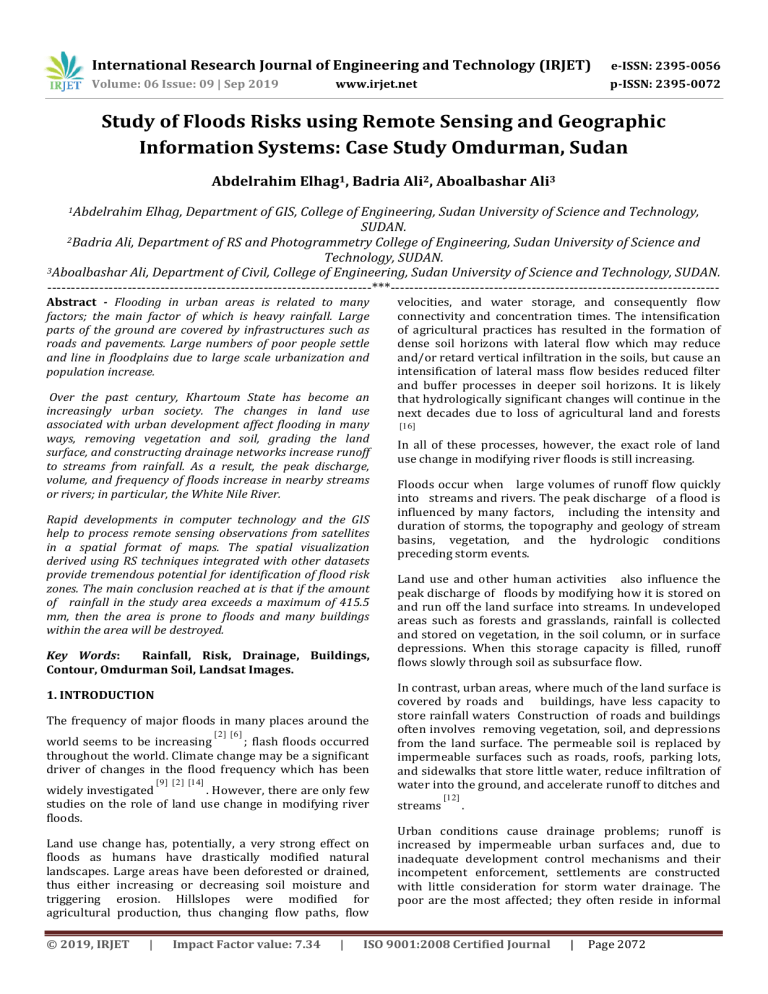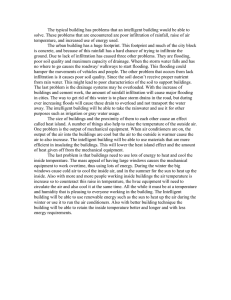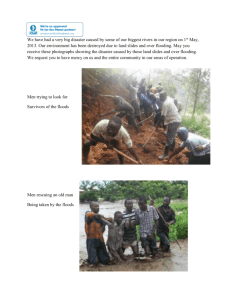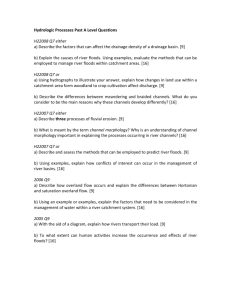IRJET- Study of Floods Risks using Remote Sensing and Geographic Information Systems: Case Study Omdurman, Sudan
advertisement

International Research Journal of Engineering and Technology (IRJET) e-ISSN: 2395-0056 Volume: 06 Issue: 09 | Sep 2019 p-ISSN: 2395-0072 www.irjet.net Study of Floods Risks using Remote Sensing and Geographic Information Systems: Case Study Omdurman, Sudan Abdelrahim Elhag1, Badria Ali2, Aboalbashar Ali3 1Abdelrahim Elhag, Department of GIS, College of Engineering, Sudan University of Science and Technology, SUDAN. 2Badria Ali, Department of RS and Photogrammetry College of Engineering, Sudan University of Science and Technology, SUDAN. 3Aboalbashar Ali, Department of Civil, College of Engineering, Sudan University of Science and Technology, SUDAN. ---------------------------------------------------------------------***---------------------------------------------------------------------- Abstract - Flooding in urban areas is related to many factors; the main factor of which is heavy rainfall. Large parts of the ground are covered by infrastructures such as roads and pavements. Large numbers of poor people settle and line in floodplains due to large scale urbanization and population increase. Over the past century, Khartoum State has become an increasingly urban society. The changes in land use associated with urban development affect flooding in many ways, removing vegetation and soil, grading the land surface, and constructing drainage networks increase runoff to streams from rainfall. As a result, the peak discharge, volume, and frequency of floods increase in nearby streams or rivers; in particular, the White Nile River. Rapid developments in computer technology and the GIS help to process remote sensing observations from satellites in a spatial format of maps. The spatial visualization derived using RS techniques integrated with other datasets provide tremendous potential for identification of flood risk zones. The main conclusion reached at is that if the amount of rainfall in the study area exceeds a maximum of 415.5 mm, then the area is prone to floods and many buildings within the area will be destroyed. Key Words: Rainfall, Risk, Drainage, Buildings, Contour, Omdurman Soil, Landsat Images. 1. INTRODUCTION The frequency of major floods in many places around the [ 2] [6] world seems to be increasing ; flash floods occurred throughout the world. Climate change may be a significant driver of changes in the flood frequency which has been [ 9 ] [ 2 ] [14] widely investigated . However, there are only few studies on the role of land use change in modifying river floods. Land use change has, potentially, a very strong effect on floods as humans have drastically modified natural landscapes. Large areas have been deforested or drained, thus either increasing or decreasing soil moisture and triggering erosion. Hillslopes were modified for agricultural production, thus changing flow paths, flow © 2019, IRJET | Impact Factor value: 7.34 | velocities, and water storage, and consequently flow connectivity and concentration times. The intensification of agricultural practices has resulted in the formation of dense soil horizons with lateral flow which may reduce and/or retard vertical infiltration in the soils, but cause an intensification of lateral mass flow besides reduced filter and buffer processes in deeper soil horizons. It is likely that hydrologically significant changes will continue in the next decades due to loss of agricultural land and forests [16] In all of these processes, however, the exact role of land use change in modifying river floods is still increasing. Floods occur when large volumes of runoff flow quickly into streams and rivers. The peak discharge of a flood is influenced by many factors, including the intensity and duration of storms, the topography and geology of stream basins, vegetation, and the hydrologic conditions preceding storm events. Land use and other human activities also influence the peak discharge of floods by modifying how it is stored on and run off the land surface into streams. In undeveloped areas such as forests and grasslands, rainfall is collected and stored on vegetation, in the soil column, or in surface depressions. When this storage capacity is filled, runoff flows slowly through soil as subsurface flow. In contrast, urban areas, where much of the land surface is covered by roads and buildings, have less capacity to store rainfall waters Construction of roads and buildings often involves removing vegetation, soil, and depressions from the land surface. The permeable soil is replaced by impermeable surfaces such as roads, roofs, parking lots, and sidewalks that store little water, reduce infiltration of water into the ground, and accelerate runoff to ditches and streams [12] . Urban conditions cause drainage problems; runoff is increased by impermeable urban surfaces and, due to inadequate development control mechanisms and their incompetent enforcement, settlements are constructed with little consideration for storm water drainage. The poor are the most affected; they often reside in informal ISO 9001:2008 Certified Journal | Page 2072 International Research Journal of Engineering and Technology (IRJET) e-ISSN: 2395-0056 Volume: 06 Issue: 09 | Sep 2019 p-ISSN: 2395-0072 www.irjet.net settlements located on marginal land (low-lying land), riverbanks, floodplains and steep hillsides [7] . Although these sites are vulnerable to the impacts of flooding, the benefits of living nearer sources of employment and urban services generally outweigh the disadvantages associated with flooding, which is generally [10] perceived as a natural and seasonal event .One can distinguish four types of flooding in urban areas: localized flooding due to inadequate drainage; flooding from small streams within the buildup area; flooding from major rivers; and coastal flooding. [ 4] . As pointed out before, poor communities often live in the most hazardous and unhealthy environments in urban debris, particularly when houses are built close to the channels. Such situations frequently arise when poor people build on low-lying floodplains, over swamps or [8] above the tidewater level on the coast . The effects of climate change are superimposed on these people-driven local land surface modifications. Over the past century, Khartoum State has become an increasingly urban society. The changes in land use associated with urban development affect flooding in many ways, removing vegetation and soil, grading the land surface, and constructing drainage networks increase runoff to streams from rainfall. As a result, the peak discharge, volume, and frequency of floods increase in nearby streams or rivers; in particular, the White Nile River. [11] areas . Many build their homes and grow their food on river floodplains in towns and cities. Others construct their shelters on steep, unstable hillsides, or along the foreshore on former mangrove swamps or tidal flats. People suffering these poor conditions may find their difficulties compounded by the consequences of climate change. In the large cities of low latitude countries, it is common for much of the low-income population to live in areas at risk from flooding, [ 3] and this population is most likely to Changes to stream channels during urban development can limit their capacity to convey floodwaters. Roads and buildings constructed in flood-prone areas are exposed to increased flood hazards, including inundation and erosion, as new development continues. Information about stream flow and how it is affected by land use can help communities reduce their current and future vulnerability to floods. 2. REMOTE SENSING (RS) AND GEOGRAPHICAL INFORMATION SYSTEMS (GIS) [1] be affected by factors related to climate change .Floods are natural phenomena, but damage and losses from floods are the consequences of human activities. Although climate change is driven largely by modernization and development, all human activities, including land degradation by poor farmers and grazing flocks, contribute to environmental change. However, on a per capita basis, the poor people are far more the victims of change than contributors to global warming and land degradation. Flooding in urban areas is not just related to heavy rainfall and extreme climatic events; it is also related to changes in the built-up areas themselves. Urbanization restricts where floodwaters can go by covering large parts of the ground with roofs, roads and pavements, thus obstructing natural channels, and by building drains that ensure that water moves to rivers more rapidly than it did under natural conditions. Large-scale urbanization and population increases have led to large numbers of people, especially the poor, settling and living in floodplains in and around urban areas [15] . As people crowd into cities, human impacts on urban land surfaces and drainage intensify. Even moderate storms now produce quite high flows in rivers because of surface runoff from hard surfaces and drains. Water flowing through a series of culverts and concrete channels cannot adjust to changes in the frequency of heavy rain, as natural streams do. They are often obstructed by silt and urban © 2019, IRJET | Impact Factor value: 7.34 | Remote sensing is a technique, which made it possible to obtain and distribute information rapidly over large areas by means of sensors operating in several spectral bands, mounted on aircrafts or satellites. The spectral bands used by these sensors cover the whole range between visible and microwaves. Rapid developments in computer technology and the Geographical Information Systems (GIS) help to process Remote Sensing (RS) observations from satellites in a spatial format of maps. The spatial visualization of information derived from RS techniques with other datasets provides tremendous potential for identification, monitoring and assessment of floods 5 . 3. DATA AND METHODOLOGY 3.1 The Study Area The study area is the locality of Omdurman, bounded by latitude 16° 39' 52.6''N (Upper), 15° 54' 45.1'' N (Lower) and longitude 31° 49' 46.4''N(Upper), 32° 36' 31.9''N (Lower), on the western bank of the River Nile and its tributary, the White Nile, comprising a total area of approximately 8203.936km2. It is linked with the two main cities, Khartoum and Khartoum North, by the White Nile, El Ingaz, Shambat, and Halfayat El Mulook bridges respectively (see Figure 1).Omdurman features a hot desert climate, with only the months of July and August seeing significant precipitation averaging little over 155 millimeters per year. Expansive soil is mainly composed of sedimentary rocks such as shell, clay stone, ISO 9001:2008 Certified Journal | Page 2073 International Research Journal of Engineering and Technology (IRJET) e-ISSN: 2395-0056 Volume: 06 Issue: 09 | Sep 2019 p-ISSN: 2395-0072 www.irjet.net lime stone, and rich in magnesium (see Figure 2). The geological units (Figure 3) in the study area are mainly composed of superficial deposits, volcanic rocks, cretaceous sedimentary rocks and basement complex. The surface of the locality is characterized by gently rolling terrain and the end of the water discharge is generally the Nile River [13] [17] The Agricultural (cultivated and non- cultivated) area totaled one million fedans. The registered part of this area is almost 954000 fedans. Land cover refers to the physical surface of the earth, including various combinations of vegetation types, soils, exposed rocks and water bodies as well as anthropogenic elements (Figure 4). ( Figure 3). Fig - 4: Land Cover of Omdurman Locality 3.2 Data Sources: Fig -1: Study Area (Omdurman Locality) Landsat imagery (TM and ETM) available from www.earthexplorer.USGS.gov repository were used to determine the drainage system and buildings within the study area. The characteristics of the Imageries is shown in Table (1) Table -1: Characteristics of the Imageries used Date 10/6/1988 10/6/1994 7/6/2000 8/6/2007 12/6/2013 Chart - 1: Rainfall Data for the years 1988, 1994, 2000, 2007 and 2013 Fig -3: Geological Map of Omdurman Locality | Impact Factor value: 7.34 Resolution (meter) 30 30 30 30 30 Rainfall data for the years 1988, 1994, 2000, 2007 and 2013 were obtained from National Metrological Authority (Sudan) as shown in Chart (1) Fig -2: Soil Map of Omdurman Locality © 2019, IRJET Sensor TM TM ETM ETM OLI | ISO 9001:2008 Certified Journal | Page 2074 International Research Journal of Engineering and Technology (IRJET) e-ISSN: 2395-0056 Volume: 06 Issue: 09 | Sep 2019 p-ISSN: 2395-0072 www.irjet.net Digital Elevation Model was obtained from the Shuttle Radar Topography Mission, (SRTM), available at 30 meters resolution. The Paz and Collischonn (2007) approach was applied to eliminate sinks form the SRTM data and to obtain the local drain direction network. 3.3 Data processing: The software used for data processing is the Arc Map version10.3 and Excel 2010 following the step below: ● Open ARCGIS. ● Choose Catalog. ● Create file. Fig – 6: Buildings and Drainage 1994 ● Import Personal Geodatabase. ● From Feature Dataset and Feature class. ● Choose Projection, Zone and Datum (in this paper, the Universal Transverse Mercator (UTM) Projection, Zone 36 and World Geodetic System (WGS84) were used). ● Form Polygon of drainage and buildings. The results of combining out these steps are shown in figures 6, 7, 8, and 9. Fig – 7: Buildings and Drainage 2000 The tributaries of rivers and buildings within the study area for different years (1988, 1994, 2000, 2007, and 2013) were identified from satellite images and the results are as those shown in figures 6, 7, 8, and 9. Fig – 8: Buildings and Drainage 2007 Fig - 5: Buildings and Drainage 1988 Fig - 9: Buildings and Drainage 2013 © 2019, IRJET | Impact Factor value: 7.34 | ISO 9001:2008 Certified Journal | Page 2075 International Research Journal of Engineering and Technology (IRJET) e-ISSN: 2395-0056 Volume: 06 Issue: 09 | Sep 2019 p-ISSN: 2395-0072 www.irjet.net 4. Results and Analysis 1. From satellite images, the tributaries of rivers and buildings within the study area for different years (1988, 1994, 2000, 2007, 2013 and 2018) are identified as shown in Figure (5, 6, 7, 8, and 9). 2. Layers created in the previous section were placed on top of each other to see the size of the impact. It is found that the buildings are not affected by the floods or rain water coming from the tributaries for the same year. This is an indication that the buildings are not affected by floods or rainwaters coming from these tributaries ; they are rather affected directly by rainfall, the magnitudes of which are shown in chart (1) 3. When the 2018 buildings were placed with the contour map of the study area, it is found that some buildings were located in low areas prone to floods as shown in Figure (10). 4. When the buildings layer for the year 2018 was overlapped with the tributaries of 1988, it is found that some buildings are constructed inside the banks of the tributaries, as shown in Figure (11). 5. When the three layers, mentioned in 2,3, and 4 above are place together and overlapped, it is found that if the rainfall rate in coming year exceeds the rainfall of 1988 (A year of drastic destruction of buildings in the study area as a result of heavy rainwater , then the study area is exposed to floods risk and the buildings there in will be at risk for vast areas within the locality, as shown in Figure (12) Fig - 11: Buildings 2018 and Drainage1988 Fig -12: Risk map of Omdurman Locality 5. CONCLUSIONS 1. In general, this study concluded that it is possible to identify areas affected or may be affected by water bodies (drainages, streams) and natural rainfall with the help of RS, GIS and DEM. 2. Also, construction and buildings constructed in low areas can easily be identified to additions areas that can be most affected in the future can also be identified. 3. The most important conclusion reached at is that areas within the locality of Omdurman are at risk to be floods if the rain water exceeds 415.5 mm. Fig -10: 2018 Buildings and Contour Map © 2019, IRJET | Impact Factor value: 7.34 | ISO 9001:2008 Certified Journal | Page 2076 International Research Journal of Engineering and Technology (IRJET) e-ISSN: 2395-0056 Volume: 06 Issue: 09 | Sep 2019 p-ISSN: 2395-0072 www.irjet.net REFERENCES [1] [2] [3] [4] [5] [6] Adger, N and 63 others, Climate Change 2007: Impacts, Adaptation and Vulnerability, Working Group II Contribution to the Intergovernmental Panel on Climate Change Fourth Assessment Report, Summary for Policymakers, Intergovernmental Panel on Climate Change, Geneva, 2007. Hall, J., et al, Understanding flood regime changes in Europe: A state of the art assessment, Hydro l. Earth Syst. Sci., 18, 2735–2772, doi: 10.5194/hess-18-27352014. Hardoy, J E, D Mitlin and D Satterthwaite, Environmental Problems in an Urbanizing World: Finding Solutions for Cities in Africa, Asia and Latin America, Earths can, London, 2001. IAN DOUGLAS el at, Unjust waters: climate change, flooding and the urban poor in Africa, Environment & Urbanization 2008 International Institute for Environment and Development (IIED).Vol 20(1): 187–205, 2008. DOI: 10.1177/0956247808089156 Jeyaseelan. A.T, “Droughts & Floods Assessment and Monitoring using Remote Sensing and GIS” (Crop Inventory and Drought Assessment Division National Remote Sensing Agency Department of Space, Govt. of India, Hyderabad), 2006. Lins, H. F., and J. R. Slack , Streamflow trends in the United States,Geophys. Res. Lett., 26(2), 227–230, 1999 [7] [8] [9] [10] [11] [12] [13] [14] [15] [16] [17] © 2019, IRJET | Impact Factor value: 7.34 | Main, H and S W William (editors), Marginal Urban Environments as Havens for Low-income Housing: Third World Regional Comparisons in Environment and Housing in Third World Cities, John Wiley and Sons, Chichester, 1994. Mc Granahan, G, D Balk and A Anderson, “The rising tide: assessing the risks of climate change and human settlements in low elevation coastal zones”, Environment & Urbanization Vol 19, No 1, April 2007, pages 17–37. Merz, B., et al, Floods and climate: Emerging perspectives for flood risk assessment and management, Nat. Hazards Earth Syst. Sci., 14, 1921–1942, doi: 10.5194/nhess-141921-2014. Parkinson, J,“Urban drainage in developing countries–challenges and opportunities”,Waterlines Vol 20, No 4, 2002. Stephens, C, I Timaeus, M Akerman, S Avle, P B Maia, P Campanerio, B Doe, L Lush, D Tetteh and T Harpham, Environment and Health in Developing Countries: An Analysis of Intra-urban Differentials, London School of Hygiene and Tropical Medicine, 1994,141 pages. USGS Science for a changing world, Effects of Urban Development on Floods. By Christopher P. Konrad, Research Hydrologist U.S. Geological Survey–Water Resources 1201 Pacific Avenue, Suite 600, 2003. Vail, J.R, “Outline of the geology and mineral deposits of the Democratic Republic of the Sudan”. Overseas Geol. Miner. Resoure, London, 49, p 67, 1978. Viglione, A., B. Merz, N. Viet Dung, J. Parajka, T. Nester, and G. Bl€ oschl, Attribution of regional flood changes based on scaling finger prints,Water Resour. Res., 52, 5322– 5340, doi:10.1002/2016WR019036. Viljoen, M and H Booysen, “Planning and management of flood damage control: the South African experience”, Irrigation and Drainage No 55, S83–S91, 2006. Wheater, H., and E. Evans, Land use, water management and future flood risk,Land Use Policy, 26, 251–264, doi:10.1016/ j.landusepol.2009.08.019. Whiteman, A., “The Geology of the Sudan Republic”, Clarendon press, London, 1971. ISO 9001:2008 Certified Journal | Page 2077





